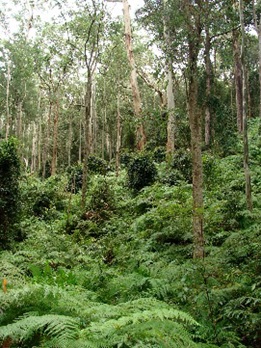On 1 April 2015 Hornsby Council’s Bushland Team led the Bushland Management Advisory Group on a visit to four reserves in the newly established Waitara Creek Upper Catchment biobanking site. The four reserves are:
- Dog Pound Creek Bushland
- Florence Cotton Park
- part of Ginger Meggs Park
- Waitara Creek Bushland
You may have seen the Hornsby Advocate story on 26 February, Agreement Prices Parks emphasising the monetary value of nature. However, Australian Plants Society members might be more interested to know that the land will be managed in perpetuity by Hornsby Council primarily for biodiversity conservation, with some passive recreation opportunities.
Through extensive research and mapping council was able to establish a $1.135 million value for maintaining and improving the land. This amount has been pledged for the land’s rehabilitation over 20 years with $1.1 million of this coming from the NSW government.
Biobanking is the scheme by which the Office of Environment and Heritage manages offsets for development on environmentally sensitive land. The scheme allows landowners in NSW to establish their land as a biobanking site, agreeing to enhance and protect its biodiversity. The site generates credits according to its value, for example, connectivity, condition, species and size, and other criteria such as cost of rehabilitation.
The calculation of the price of a credit is complex. It includes the estimated cost to the landholder of managing the land for the life of the agreement as well as establishment costs. The landholder must pay an application fee and provide a field assessment, management plan, land valuation and opportunity costs. The Office of Environment and Heritage website explains the processes.
The main forest types in these reserves are Blackbutt Gully Forest and Peppermint Angophora Forest. Also an area of Blue Gum Diatreme Forest which is significant because it is critically endangered, is found in the Hornsby Volcanic Diatreme system. It has lost 95% of its original extent through mining and logging and half the remaining area will be conserved by this agreement.
The reserves are home to four NSW threatened plants species including:
- Galium australe (Tangled Bedstraw) once thought extinct and now found in Dog Pound Creek, listed as endangered
- Grammitis stenophylla (Narrow-leaf Finger Fern) listed as vulnerable
- Epacris purpurascens var purpurascens, listed as vulnerable
- Syzigium paniculatum (Magenta Lilly Pilly, Magenta Cherry, Pocket-less Brush Cherry, Scrub Cherry, Daguba or Cadigal, Creek Lilly Pilly or Brush Cherry) although commonly cultivated, is listed nationally as vulnerable and endangered
Below left: Blue Gum Diatreme Forest is restricted to gullies on Jurassic diatremes (volcanic necks) along tributaries of Waitara Creek; here shown along Larool Creek, Dog Pound Track, Westleigh
Below right: Track through Florence Cotton Reserve, a Blackbutt Gully tall open forest found in gullies on Hawkesbury Sandstone with a shale influence from shale lenses in the sandstone or from proximity to Wianamatta Group shales













